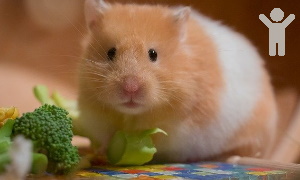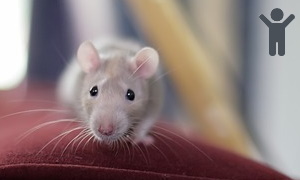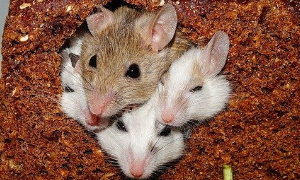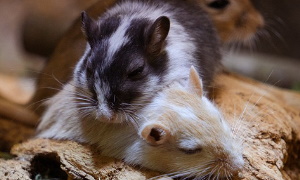
How-to guide for building your own bin cages. Bin cages can be a good choice for temporary accomodation.
Bin Cage Building




Some animals need to be introduced on neutral territory. This guide explains how to do so safely.
Neutral Territory Introductions
Information on quarantine practices for introducing new animals or for preventing the spread of illness.
Quarantine Methods
Animals can be excellent at concealing illness, especially if they are a prey species. Find out what signs to look out for.
Signs your Animal is Ill
Some animals such as Mongolian Gerbils cannot be directly introduced. Find out how to introduce them safely.
The Split-Cage MethodBall fighting is where two rodents curl into a ball together and are fighting each other. This is a serious escalation and needs to be separated, ball fighting can occur after a serious of interations or without buildup. Gerbils in particular must be separated if this happens as this is a fight to the death.
Bar Biting is often caused by boredom, but can develop into a habit if left unchecked. Bar biting can cause misaligned teeth and depression. If your pet is bar biting you need to look at your cage layout and sizing, ensuring the wheel is larger enough, their is plenty of enrichment, space and toys. Remember to change toys occasionally to keep your pet interested. If your cage is large enough and your pet has plenty to do and are still doing this, you may need to look at putting them in a well ventilated tank or large enough bin cage to stop this.
Some rodents rise on their hind legs and bat at each other with their front paws. This can be play-fighting and fairly minor, but if one animal does not back down or lose interest this can escalate.
Bruxing is where an animal grinds or chatters its teeth together quite rapidly. This can indicate contentment, especially when occompanied with boggling. However bruxing can also occur as a reaction to pain or stress — if the sound is louder, and with more sharp cracks, it is more likely to be the animal responding to something bad. Rodents may brux loud (sometimes known as chattering) to comfort themselves if they are in distress or pain. Rats are particularly known for this.
As a prey species, rodents have a strong survival instinct and so when a companion dies they may well eat the body to dispose of it - and thus leave no traces for a predator to help locate them. Some rodents may cannibalism their young if the nest is disturbed too early, or they are distressed for other reasons. Sometimes this can indicate a lack of protein in their diet.
Sometimes rodents that have lived together for a long time can have serious fights and decide they can no longer live together. This is known as declanning. Female gerbils are known for this in later life, if kept in numbers greater than a pair. If declanning occurs in a pair then you may be able to reunite using the split-cage method, but you cannot introduce a single gerbil to an existing pair or clan. If blood hasn’t been drawn then one of the most common problems may be odour, say if you handled one rodent without handling the other or if there is as strong smell in the room such as if you have recently painted. A dust bath is a good start to try and neutralise this for some species. Sometimes this isn't declanning, but where a species has been sold to an owner without the proviso that they may not have a good chance at staying together for life. Dwarf hamsters from pet shops for instance, can be difficult as they will be hybrids - and so may have inherited different percentages of traits and not be compatible with each other.
A certain amount of dominance play will be how your group establishes its hierarchy. Although this is often spoken of as needing an Alpha - this is not a concrete rule. Dominance behaviour includes pinning - where an animal will hold another in a position where their belly is upwards. They might then groom or sniff them, or just do nothing. This is normal. Grooming is a dominance behaviour and it may seem sometimes as if this is being forced. This is particularly common where an animal has been kept incorrectly without companions, one result is that the lonely animal may groom quite excessively when finally introduced to company. This should only become a concern if the grooming becomes excessive to the extent that other animals fur is becoming patchy, or fights are breaking out because of the over enthusiastic one.
Fur pulling is a sign of stress and is something Chinchillas are prone to. Fur pulling can be a reaction to a stressful or unhealthy environment, a fear response, or a sign that your animals are bullying each other. You must identify the cause and improve the triggers to help your Chinchilla improve, if left ongoing for too long this can become a habit. It is also important to get this behaviour checked at the vet as it may be caused by another skin condition such as mites or allergies.
Grooming is a something rodents do to themselves, and to each other. Sometimes this is a bonding behaviour but it can also be dominance, especially whilst establishing hierarchy. See dominance behaviour for more details. Rodent may groom themselves whilst nervous, using teeth and claws. It can look like they are nibbling at their fur. Rodents do this to keep themselves clean, although some species may also require a dust bath to prevent fur from becoming too greasy.
Head Swaying is something a pink or red eyed animal may do to compensate for some distortion in their vision. However, it can be an indication of an issue such as ear infection and should be investigated.
Rodents moult their fur from pup to adult where a baby coat is replaced with a smoother adult version. Some changes also occur as adults, Nutmeg gerbils for example, have quite dramatic colour changes and the lines of this can sometimes be seen quite clearly along their fur. Winter White Hamsters will change coat colour as the light changes in winter, as a natural camouflage against the snow.
This can sometimes be a form of dominance behaviour, or an indication that one animal is in heat. This is mostly harmless although worth keeping an eye on if one animal is persistent in case it leads to more serious behaviour. If this is observed with new animals, it is always worth double and triple checking genders in case an error has been made!
Some rodents will use their scent glands to mark their territory. It is often a high-ranking or alpha that will do this most, and they may also secrete small droplets of urine as a form of marking. This does not indicate incontinence and not all rodents will do this. Cleaning out rodents too often may lead to excessive scent marking. Not only will this actually lead to a greater overall smell, but more importantly this puts a greater strain on their kidneys.
Stereotypical behaviour is a behaviour a rodent exhibit typically when coming from an overcrowded home or where kept without important aspects. Rodents such as gerbils for instance will develop compulsive burrowing in the corner of a cage if brought up without a burrow. If mum is given an artificial burrow - an enclosed chamber with tunnel attached - then these pups will grow up without this behaviour. Another stereotypical behaviour is bar chewing, and this is something that can be improved by ensuring the rodent has enough space and toys to alleviate the boredom. Some rodents may keep exhibiting this behaviour regardless. Excessive wheel running is another troublesome behaviour, and this can be tackled by offering the wheel in limited time slots or even removing completely. It's important to monitor the weight of any rodent that develops an obsession with their wheel!
Some rodents rattle or thump their tail. This can be used to express aggression, annoyance or sometimes is a sexual behaviour.
A collection of pus in a localised position. Abscesses can be caused by fights and are generally softer than cancerous lumps.
These can appear as swellings on any part of the body. They will normally be soft although can harden if pressure builds up. They can have discharge which will dampen and discolour the fur around it. Abscesses can feel similar to tumours.
Vet treatment necessary to identify, lance and drain the abscess. Position of abscess can cause additional difficulties, with ones obstructing toileting or to the face being especially problematic. Antibiotics may be required for large or multiple abscesses.
Excess scratching, sneezing, runny or swollen eyes are signs that your pet may have an allergy. There are many causes of allergies, including substrate and food. Some mice are prone to allergies to sunflowers. A common cause is bedding or substrate, so it is worth switching their bedding and substrate to see if this can solve the problem. If you see no improvement after a few days then it will require a vet visit.
Barbering can be caused by rodents overgrooming or chewing the fur or whiskers from another rodent. This can be caused by stresses such as overcrowding, poor diet or dominance issues. Excessive barbering may require separation of the animals.
This is a common ailment that affects rodents kept on abrasive surfaces such as wire, unsuitable wheels, or who have to sit in soiled bedding for long periods of time. Signs: Inflammation of the skin, leading to skin infection. Treatment: Vets may prescribe antibiotics. Remove wire surfaces and provide clean bedding.
Cataracts in rodents can be spotted initially be seen as a white dot behind pupil and the lens may develop a gray or milk white discoloration. They are more likely to occur in older animals. A vet should be consulted and some adaption of cage layout to account for poorer vision may be needed.
Cushings Disease is a disease known in Syrian Hamsters, caused by a tumour in the pituitary gland. Signs of Cushings Disease include hair and weight loss, loose and flaky skin, increased thirst, dark pigment patches on the skin and cuts, scabs and wounds to the skin. Cushings typically occurs in hamsters over one year old. Your vet can prescribe treatment to manage some of the symptoms such as dry skin, but there is no current liscensed medication for the disease.
Degloving is where the fur, skin, and muscle have been torn off an animal’s tail, leaving muscle and bone exposed. This is an extremely painful injury and will need vet treatment including pain relief. The missing part of the tail may never grow back but could potentially be amputated. Degloving can be caused by fights or injuries in cages.
Diabetes is where an insufficient amount of insulin is produced and can be identified by the increased thirst, frequent urination and weight loss. Hybrid hamsters are especially likely to develop this, as are Campbells Russian Dwarf Hamsters and Chinese Hamsters. Diabetes can be identified by testing urine for glucose and can be controlled with careful diet management. Diabetes can increase the liklihood of a hamster developing cateracts.
It is important to ensure your animals are kept well hydrated so check their water bottles and bowls. A common cause of diarrhoea in mice is too many green vegetables in their diet. Mild cases of diarrhoea can be treated by sprinkling Arrowroot powder over their normal food. Arrowroot can be obtained from most herbal food shops or your local supermarket. Diarrhoea can be very serious in young or vulnerable animals. Diarrhoea can be a sign of a pet developing more serious diseases such as Wet Tail or Tyzzers disease so it is very important to seek vetinary treament.
Crusty spots to the ears, face, feet and genitals and dark-coloured wax in the ears can be signs of ear mites. Vets may prescribe diluted Ivermectin via mouth drops or injection. This can involve multiple treatments.
Many rodents do not have good eyesight, relying more on their scent of smell. Many blind rodents and small mammals can still have excellent quality of life, though some adjustments need to be made to cage layout to reduce possible injuries and provide a sense of security. Animals with red or pink eyes have poorer vision than those with black. They may sway their head from side to side, as they have more difficulty focusing. As rodents rely more on smell, than sight, this does not affect their quality of life.
See also Cateracts, Glaucoma, Microphthalmia (ill-formed eyes) and Porphyrin (red tears).
Fur Fungus is something that can occur in Chinchillas, it is contagious to animals and people and is the same fungal infection that causes Athletes Foot. it can be identified via bare patches of fur, dry flaky skin and occasionally blister-like lesions. Fur Fungus occurs in damp fur and needs urgent vet treatment.
Glaucoma is a condition where pressure in the eyeballs is greater than normal and can be identified by swelling around the eyes. Glaucoma in rodents in currently not treatable, although your vet can prescribe eye drops. Issues with visions may require care taken with cage layouts, to avoid sudden drops or changes. Winter White Hamsters are known for developing Glaucoma and it can also be caused by an injury that impairs normal eye drainage.
Hair loss can be caused by many things, including mites and allergies. It can also be an indication of Diabetes and is the first stage of Cushing disease. It is normal for fur to thin over time due to age and hair can look untidy or thinner than normal during a moult.
A persistent head tilt needs to be investigated by your vet, this could be a sign of an ear infection or something more serious. This is different to Head Swaying, which is something a pink or red eyed animal may do to compensate for some distortion in their vision.
Hydrocephalus is a build up of fluid on the brain. Another term for this is Brachycephalic, due to the shortening of the snout which is called Brachycephaly. However, a Brachycephalic hamster does not always have Hydrocephalus. Hydrocephalus causes brittle teeth, respiratory problems, and bulging eyes and brings an increased risk for respiratory infections and eyes issues.
Extra care must be taken with substrate to avoid additional irritation to your pet. There is no cure for Hydrocephalus and it can be an inherited condition. Asian Garden Dormice can be prone to this, potentially due to inbreeding in the UK given bloodlines are not tracked.
Malocclusion is where teeth have not been worn down correctly, and the excess growth has caused them to grow misshapen. Signs include difficulties eating, weight loss, swelling to the mouth or face, excess salivation.
Your vet can clip the teeth. This can be a condition that reoccurs and needs regular appointments. This will not affect your pets quality of life and the same diet should be offered.
This condition is present from birth and is where one or both eyes are not properly formed. The eyes are smaller than normal and the hamster may have limited or zero vision. There is no treatment for this.
Hamsters have cheek pockets in the wall of their mouth, which are used to transport food. These can be affected by the following:
Cheek Pouch Impaction: Sometimes a hamster can be unable to empty their own cheek pouches, which can occur due to issues with the food size or stickiness, or where existing dental problems exist. A vet can empty the cheek pouches under light anaesthesia.
Cheek Pouch Eversion: It is possible for one or both pouches to become everted (i.e inside-out). Dwarfs are more prone to this than Syrians. This condition requires vet treatment urgently, as this condition can lead to damaged or necrotic skin.
Pyometra is a serious, life-threatening condition where the uterus becomes infected. It is more likely to occur in older animals. This can be identified by a discharge of blood or pus from the vulva, known as an open pyrometra.
Pyrometra can also be closed, which means that the cervix is closed and the blood and pus are not draining from the body. This causes the abdomen to bulge and increases internal pressure, which results in blood poisoning.
Pyrometra must be treated urgently, with spaying often recommended.
Neutering can be done on male animals in order to enable them to live with the opposite sex without risk of babies. This does require an experienced vet and time will be needed after the operation before the animal is safe to be introduced to the opposite sex. Female animals can be spayed, with can reduce the risk of developing some cancers. Spaying is a more complicated procedure than neutering. Male mice can be neutered, which allows them to then live with female mice which can be a good solution to an otherwise solitary existence since male mice are very difficult to keep together with their own gender without fighting.
Parvoviruses attack rapidly dividing cells and are species specific, for example the Rat Parvovirus (RV) is also known as Kilham rat virus and under natural conditions will only affect rats.
The red colouring in gerbils tears are caused by an organic compound known as porphyrin. These causes the 'red tears' that can look like blood. This can be caused by allergies to substrates - a common cause is using sawdust, a substrate which is not suitable for rodents.
A prolapsed penis (paraphimosis) can occur in even the smallest of rodents and should be referred to a vet if it persists.
Any animal that has issues with breathing, either due to speed or noise, should see a vet. A rodent that makes an audible noise, like a snuffling or clicking sound, may have a respiratory infection. Mycoplasma pulmonis is the most common cause of respiratory infections in rats and mice who are three months or older.
Ringworm is a skin lesion that can result in fur loss, although some rodents can display no symptoms. Some variants can be communicable to humans. This is usually treated with topical antibiotic/steroid creams or antifungal medications.
Hamster scent glands differ depending on the gender and species of the hamster. Syrian hamsters have bilateral scent glands, meaning they have two, one on each hip whereas the dwarf species have a single scent gland on their underside. They are flat in appearance and may appear wet or greasy looking, a distressed hamster may emit a smell from this gland. Scent glands are more prominent in males, than females. Gerbils have scent glads in the middle of their tummy. Rodents often mark territory by rubbing their scent glands on it.
Scent glands can develop infections and tumours, when regularly handling your pet you should get used to the normal appearance of the scent gland as it does vary by individual, any significant change in appearance or odour should be investigated by a vet. Male gerbils are prone to developing tumours but thankfully the operation to remove these has a high success rate.
Excessive scratching or grooming can led to serious skin problems. This can be caused by Mites, and the affected animal may display anything from mild scratching to severe, with patchy hair and skin ulcerations. Beaphar spot-on can be a good treatment, bearing in mind adjustment must be made for the weight of your mouse. More serious causes of mites may require your vet to prescribe something such as Ivermectin. Another cause of habitual scratching could be boredom, see our section on enrichment and general care for ideas of how to keep your mice happy. You may also want to consider changing your substrate as some animals can have allergies to a specific type.
Seizures are a very upsetting thing to watch and it is best to adapt your cage layout to ensure your rodents safety if this is something they are prone to. They can have a variety of causes, including epilepsy, and a vet should be consulted. Young gerbils may experience seizures that they grow out of.
Sendai Virus (SV) is also called parainfluenza is a common type of respiratory infection, which can affect mice, rats and hamsters.
Rodent's teeth are constantly growing throughout their lives and it is essential to provide material to help wear it down. Occasionally an animal with a jawbone or teeth abnormality such as Malocclusion may need regular trips to a vet to trim their teeth. Dental Caries, or tooth decay, can occur in rodents and can occur where an animal is fed too many sweet or honeyed treats.
On occasion, rodents may need manual tooth cutting where the normal grinding action of chewing on toys, hay and food hasn’t kept them properly worn down. You can spot this as a problem where the teeth begin to curve, sticking out between the lips. If left unchecked, this can start to grow back towards the gums or roof of your pets mouth. A good vet can trim these teeth, and tooth trims should not be painful for your pet although they may become stressed. A pair of small nail clippers or suture scissors can be used to trim the teeth, with care being taken that this isn’t done too short.
Torpor is a state where an animal has tried to hibernate and their bodies have begun to shut down. Although hamsters in the wild can hibernate, this is down with them taking months to prepare by eating extra food and preparing their nest. A pet entering torpor is very dangerous, especially if the animal has a low weight. A pet in torpor needs to be warmed up and brought out of this state. A pet in torpor may still have eyes half or fully open.
Signs of torpor include: Shaking and shivering, Limpness to body, Slow or undetectable heartbeat, Body still and in a comatose-like state.
A pet in Torpor should be slowly warmed up as soon as possible, you can do this by wrapping your pet up in a warm blanket and holding them against your body to give them heat. Snugglesafe pads are a good addition to a cage, once heated these offer up to eight hours of extra heat and come with washable covers. A quick and cheap alternative to this is to fill a sock with grains of rice, tie a knot in it and heat on low power in the microwave. This is best done in small increments, checking it every 30-45 seconds to ensure you don’t overheat. Pets should be offered plenty of bedding and shelter to enable them to make nests, with extra material being offered in the winter months.
Lumps are sadly quite common in some animals, especially with female mice. They can be caused by a variety of issues, such as an abscess (often caused by fighting), polyp, prolapse or a cancerous tumour. Some research suggests that mammary tumours have a very high possibility of recurrence as there is a chemical in the lumps that prevent others occurring. Scent gland tumours in gerbils can be removed by an experienced vet. Abscesses are generally softer than cancerous lumps and can be drained by your vet. An animal with a lump may still have many months of life left, depending on its location and does not need to be put to sleep until it begins showing signs of pain or unhappiness.
This is a highly contagious and often fatal disease. It can occur in hamsters without developing any symptoms, although others will show lethargy, ill-kept coat and diarrhoea. Tyzzer’s Disease is caused by stress and unclean environments so can be mostly prevented with good hygiene practices.
Wet Tail is a form of watery diarrhoea that is extremely serious in hamsters, if left untreated your hamster will die of dehydration. Wet tail can be caused by poor or stressful conditions, and is sadly quite common in hamsters bought from pet shops or unethical breeders. Wet tail is mostly seen in Syrian Hamsters. Any hamster with suspected Wet tail must be isolated as it can be highly contagious. Immediate vet treatment is needed.